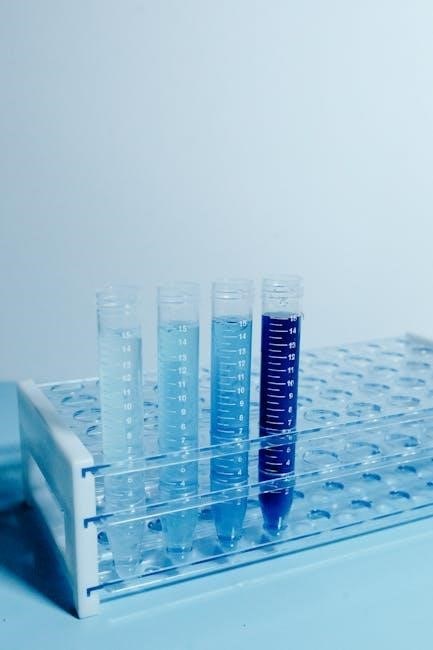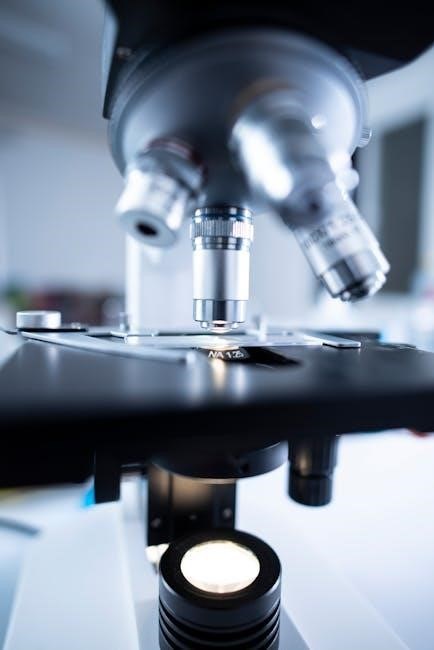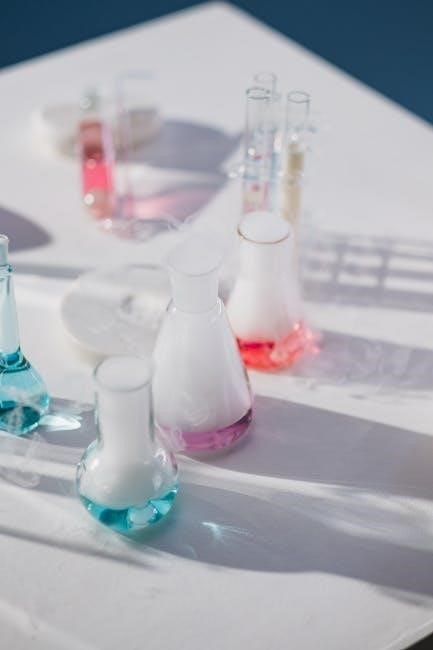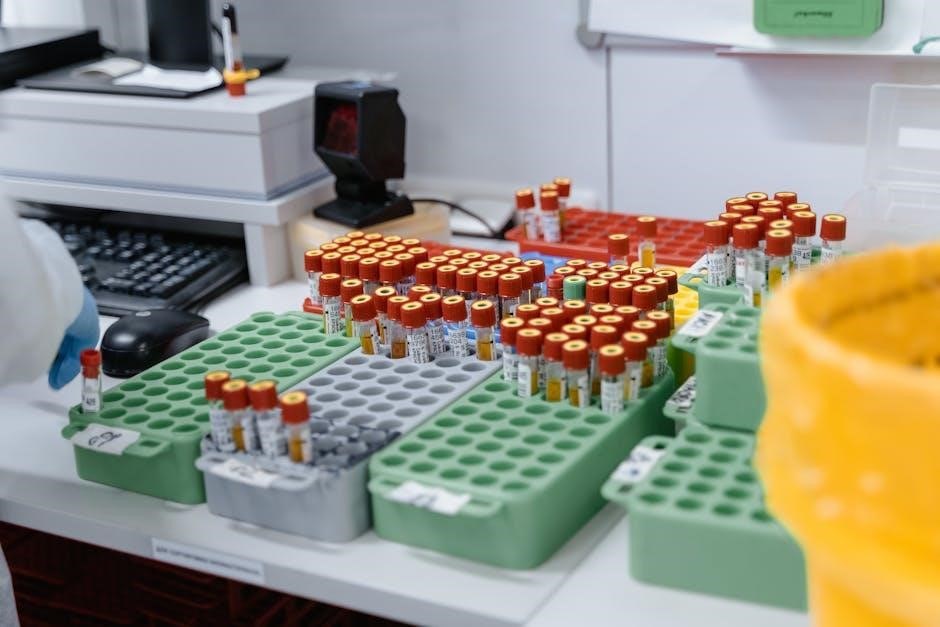
lab glassware names and pictures pdf
Lab Glassware: Identification and Usage Guide
Laboratory glassware is essential in scientific research, requiring proper identification.
This guide provides an overview of common glassware types, aiding in accurate
identification and understanding their specific uses. Proper handling ensures
experimental success and safety in the laboratory environment.
Lab glassware is the backbone of any chemistry or biology laboratory, playing a crucial role in experiments and research.
Accurate identification and proper usage are paramount for precise and reliable results.
This introduction provides an overview of various types of lab glassware, highlighting their specific functions and applications.
From beakers and flasks to cylinders and pipettes, each piece of glassware serves a unique purpose in scientific investigations.
Understanding the characteristics of different glassware is essential for students, researchers, and lab technicians alike.
This knowledge ensures that experiments are conducted safely and efficiently, leading to accurate data collection and analysis.
Moreover, familiarity with lab glassware contributes to a deeper understanding of experimental procedures and techniques.
This guide will serve as a valuable resource for identifying common lab glassware and understanding their uses in various scientific disciplines.
By mastering the basics of lab glassware, individuals can enhance their skills and contribute effectively to the advancement of scientific knowledge.
Therefore, let us embark on this journey to explore the fascinating world of lab glassware and unlock its potential for scientific discovery.
Common Types of Lab Glassware
The laboratory contains diverse glassware, each designed for specific tasks. Beakers, flasks, cylinders, and pipettes are common examples. This section
details these types, explaining their uses and variations, which is
essential for lab work.
Beakers: Uses and Types
Beakers are ubiquitous in laboratories, serving as versatile containers. They are primarily used for mixing, stirring, and heating liquids. While beakers often feature volume graduations, they are intended for approximate measurements rather than precise quantification. Available in various sizes, from small 50 mL beakers to larger 4000 mL capacities, they accommodate diverse experimental needs.
Common types include Griffin beakers, characterized by their low form and spout, and Berzelius beakers, which are taller and lack a spout. Beakers are typically constructed from borosilicate glass, ensuring chemical resistance and thermal stability. Though not suitable for accurate volume determination, their wide mouth facilitates easy pouring and access.
Beakers also find application in solids testing and wastewater analysis. For instance, they are utilized to hold samples during dissolution or reaction processes. Due to their simple design and durability, beakers represent a fundamental piece of laboratory equipment.
Flasks: Round-Bottom, Erlenmeyer, and Volumetric
Flasks are essential laboratory glassware, each designed for specific applications. Round-bottom flasks excel in heating and reactions, their spherical shape ensuring even heat distribution. They are often used with heating mantles or oil baths. Erlenmeyer flasks, with their conical shape and narrow neck, are ideal for mixing and swirling liquids without spillage. Their design also allows for easy titration.
Volumetric flasks are specialized for preparing solutions of precise concentrations. They feature a long neck with a calibration mark, indicating the exact volume at a specific temperature. Unlike beakers and Erlenmeyer flasks, volumetric flasks should only be used for creating solutions of a fixed volume, not for general mixing or heating.
These flasks often come in borosilicate glass, ensuring chemical resistance. Proper handling and cleaning are crucial for maintaining accuracy and preventing contamination in laboratory experiments. Understanding the distinct uses of each flask type is vital for successful scientific work.
Cylinders: Graduated Cylinders and Their Accuracy
Graduated cylinders are essential for measuring liquid volumes in the laboratory. These cylindrical vessels feature markings along their height, allowing for approximate volume determination. Available in various sizes, graduated cylinders are used for dispensing liquids when high precision is not required. While not as accurate as volumetric pipettes or flasks, they provide a convenient method for quickly measuring liquids.
Accuracy in measurement depends on reading the meniscus, the curved surface of the liquid, at eye level. Graduated cylinders are typically less accurate than volumetric glassware due to their wider bore and larger graduation intervals; Factors like temperature and calibration also affect accuracy.
For precise measurements, volumetric glassware should be preferred, but for routine tasks, graduated cylinders offer a practical balance of speed and accuracy. Proper cleaning and handling are crucial to maintain the integrity of measurements. Always select a cylinder size that closely matches the volume being measured to minimize error.
Pipettes and Burettes: Dispensing Precise Volumes
Pipettes and burettes are essential tools in laboratories for accurately dispensing liquids. Pipettes, available in various types such as graduated, volumetric, and Pasteur pipettes, deliver specific volumes with high precision. Volumetric pipettes are designed to deliver a single, fixed volume, while graduated pipettes allow for dispensing variable volumes.
Burettes, long cylindrical tubes with a stopcock at the bottom, are used for titrations and dispensing precise volumes of liquids. They allow for controlled addition of a solution, drop by drop, enabling accurate determination of reaction endpoints.
Both pipettes and burettes require careful handling and calibration to ensure accuracy. Reading the meniscus correctly and avoiding air bubbles are crucial for precise measurements. Proper cleaning and maintenance are also essential for preventing contamination and ensuring reliable performance. The choice between pipettes and burettes depends on the specific application and the required level of accuracy for dispensing liquids in experiments.
Test Tubes and Their Applications
Test tubes are ubiquitous in laboratories, serving as versatile containers for various chemical and biological experiments. These cylindrical glass tubes, typically closed at one end, come in different sizes and are used for holding, mixing, and heating small volumes of liquids or solids. Their simple design and ease of handling make them ideal for a wide range of applications.
In chemistry, test tubes are used for conducting reactions, observing color changes, and performing qualitative analyses. They are also essential in biology for culturing microorganisms, performing cell-based assays, and conducting biochemical tests. The inert nature of glass ensures that test tubes do not interfere with the reactions or contaminate the samples.
Test tubes can be easily labeled for identification and organized in racks for efficient handling. They can be heated directly using a Bunsen burner or placed in water baths for temperature control. While not designed for precise volume measurements, test tubes provide a convenient and cost-effective solution for many laboratory tasks.

Identifying Lab Glassware
Accurate identification of lab glassware is crucial for successful experiments.
Shape, size, and markings are key identifiers.
Understanding these features ensures correct usage, reduces errors, and maintains
safety in the laboratory setting, promoting reliable results.
Shape and Size as Identifiers
The shape and size of laboratory glassware are fundamental identifiers, offering immediate clues to their intended use. Beakers, for instance, typically cylindrical with a flat bottom and a lip for pouring, come in various sizes from 1 ml to 4000 ml; Their primary use involves mixing chemicals and measuring approximate volumes, easily distinguished by these features.
Flasks exhibit diverse shapes, including round-bottom, Erlenmeyer (conical), and volumetric, each designed for specific purposes. Graduated cylinders, tall and cylindrical, are designed for precise volume measurements. Test tubes are small, cylindrical vessels used for conducting small-scale reactions.
Pipettes and burettes, long and narrow, are used for dispensing precise volumes of liquids. These distinct shapes and sizes provide quick visual cues for proper glassware identification. Recognizing these characteristics is essential for accurate laboratory work, helping prevent errors and ensuring experimental integrity. The variety in shape and size reflects the diverse functions performed in a laboratory setting, from simple mixing to precise volumetric analysis.
Markings and Graduations on Glassware
Markings and graduations on laboratory glassware are vital for accurate measurements and identification. Graduated cylinders and volumetric flasks feature precise markings indicating specific volumes, essential for preparing solutions of fixed concentration. These graduations enable scientists to measure liquids accurately, ensuring the reliability of experimental results.
Beakers often have approximate volume markings, useful for estimations but not for precise measurements. Pipettes and burettes have finely calibrated scales for dispensing precise volumes during titrations and other analytical procedures. The accuracy of these markings is crucial; therefore, glassware is often calibrated to meet specific standards.
Additionally, glassware may have other markings, such as a white spot for labeling contents, aiding in organization and preventing confusion. Permanent markings for identification and traceability are essential in laboratory settings. These markings ensure that glassware is correctly used and that experimental data is accurate and reproducible. Recognizing and understanding these markings are fundamental skills for any laboratory worker.

Lab Glassware Material and Durability
Lab glassware’s material greatly impacts its durability. Borosilicate glass offers excellent chemical resistance and thermal stability. Proper handling and cleaning are crucial for maintaining glassware integrity, ensuring reliable and safe laboratory practices.
Borosilicate Glass: Properties and Advantages
Borosilicate glass is a superior material in lab glassware due to its unique properties.
Its low coefficient of thermal expansion makes it resistant to thermal shock, preventing
cracking under rapid temperature changes. This is crucial for heating and cooling
experiments.
Its excellent chemical resistance ensures it doesn’t react with most chemicals,
maintaining purity in reactions. Borosilicate glass withstands corrosive substances,
making it ideal for demanding applications.
The clarity of borosilicate glass allows for easy observation of reactions,
facilitating accurate measurements. Its durability reduces the risk of breakage,
ensuring safety in the laboratory.
Borosilicate glass is reusable and autoclavable, promoting sustainability. Its
reliability and long lifespan make it a cost-effective choice for laboratories,
reducing replacement frequency.
This type of glass meets strict standards, guaranteeing consistent performance.
Borosilicate’s inertness prevents contamination, ensuring reliable results in
sensitive experiments. This makes it a staple in various scientific disciplines.
Chemical Durability of Lab Glassware
The chemical durability of lab glassware is crucial for reliable experiments.
Borosilicate glass, widely used, exhibits excellent resistance to chemical attack.
This ensures that the glassware does not react with or contaminate the substances it
holds.
Acids, bases, and organic solvents pose minimal threat to borosilicate glass. Its
inertness helps to maintain the purity of reactions. The glass withstands repeated
exposure to harsh chemicals without significant degradation.
Proper cleaning is vital to preserve chemical durability. Residues from previous
experiments can compromise future results. Thorough rinsing and appropriate cleaning
agents are necessary.
Autoclaving, a sterilization method, is safe for borosilicate glassware. It endures
high temperatures and pressures without losing structural integrity.
However, hydrofluoric acid and concentrated alkaline solutions can corrode the glass.
Avoid prolonged exposure to these substances.
Different types of glass have varying chemical resistance. Understanding these
differences is essential for selecting the appropriate glassware. Regularly inspect
glassware for signs of etching or clouding. Replace damaged glassware to maintain
experimental accuracy and safety.

Cleaning and Maintenance of Lab Glassware
Proper cleaning and maintenance are essential for ensuring the longevity and accuracy
of lab glassware. Residues from previous experiments can contaminate subsequent
reactions, leading to unreliable results. Therefore, a meticulous cleaning protocol
is crucial.
Begin by rinsing glassware immediately after use to prevent residues from drying and
becoming difficult to remove. Use appropriate solvents to dissolve any remaining
substances. For stubborn residues, soaking the glassware in a detergent solution
may be necessary.
Scrub the glassware with a brush specifically designed for lab equipment. Avoid
abrasive cleaners, as they can scratch the surface and weaken the glass. Rinse
thoroughly with distilled or deionized water to remove all traces of detergent.
For sterilization, glassware can be autoclaved or heated in a dry oven. Ensure that
the glassware is completely dry before storing it to prevent the growth of mold or
bacteria.
Regularly inspect glassware for chips, cracks, or other damage. Damaged glassware
should be discarded to prevent accidents and contamination. Store glassware in a
clean, dry, and organized manner to protect it from breakage and contamination.

Safety Precautions When Handling Lab Glassware
Handling lab glassware requires strict adherence to safety precautions to prevent
accidents and injuries. Glassware can break, shatter, or cause chemical exposure
if not handled carefully. Always wear appropriate personal protective equipment
(PPE), including safety goggles, gloves, and lab coats, to minimize risks.
Inspect glassware for cracks, chips, or other damage before use. Damaged glassware
should be discarded properly, as it is more prone to breakage. When heating
glassware, use appropriate heating methods and equipment, such as heating mantles
or water baths, to ensure even heat distribution and prevent thermal shock.
Never heat closed containers, as pressure buildup can cause explosions. Use caution
when inserting glass tubing into stoppers or rubber tubing, as this is a common
cause of breakage. Lubricate the glass tubing and use a twisting motion to avoid
applying excessive force.
When disposing of broken glassware, use a designated sharps container to prevent
cuts and punctures. Clean up any spills immediately and use appropriate spill
control measures. Always wash your hands thoroughly after handling glassware and
before leaving the lab.